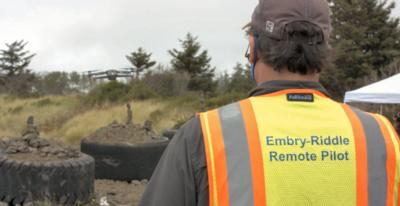Embry-Riddle, Verizon Partner On Novel Marine Conservation Program
In an effort to safely and humanely rescue marine mammals, Embry-Riddle Aeronautical University has partnered with marine biologists and a Verizon drone-management platform to monitor animals in distress using unmanned aircraft systems.

A video produced by Verizon features Gennifer Brookshire, a marine biologist and FAA-certified drone operator, who explains that attempting to reach marine mammals in need can sometimes disturb them, whether rescuers approach from the shore or by boat. Seals in the video are shown entangled in fishing line, while others in need of medical treatment are carried off the beach in stretchers.
Drones, however, can be used to assess similar situations without worsening the animals’ distress. That’s where Embry-Riddle comes in to help, said David Thirtyacre, assistant professor in the College of Aeronautics Worldwide Campus.
Eagle researchers were asked by the marine biologists to determine what type of unmanned aircraft would be most useful for marine mammal rescues while creating the smallest disturbance to animals being monitored, and to nearby wildlife.
“The biologists came to us and said, ‘What would be the best drones to use? Which drones would allow a close enough approach to study the wildlife without the noise causing stress or anxiety?’” Thirtyacre said, adding that no research had previously been conducted on the acoustic signature of consumer drones amid the ambient noise of the ocean.
Embry-Riddle is also involved in a project to better understand the behavior of multiple sea turtle species along Florida’s Space Coast, teaming up with aviation leader Northrop Grumman and the Brevard Zoo to launch a drone-based surveillance effort.
In the project with Verizon, the research team — which also included Dr. Joe Cerreta, assistant professor of Aeronautical Science, and Patrick Sherman, Worldwide Campus Department of Flight adjunct faculty member — used Skyward, a drone-management system owned by Verizon, to assess the decibel and frequency levels at which drones operate in the marine environment. Thirtyacre said Skyward was utilized from the planning stages, through safety assessments and actual flights. Afterward, all the data from the test flights was downloaded into Skyward and analyzed.

“Now we can supply not only the marine biologists with which drones are the quietest and will have the least impact on the sea animals, but we’re also going to make the data available to the government and agencies that issue permits, so they have a better idea of what aircraft work best in these types of environments,” Thirtyacre said, adding that marine biologists Sarah Callan and Brittany Arivizu also participated in the project.
College of Aeronautics Dean Kenneth Witcher said the partnership between Embry-Riddle and Verizon provides a unique opportunity.
“Through partnerships with companies like Skyward/Verizon, we are able to discover the value of remotely piloted aircraft systems in very innovative ways from a professional aviation perspective, leveraging our experience and safety culture,” Witcher said.
Brookshire said the data will also be shared with other scientists and rescue organizations, so they can incorporate drones into their efforts and get more information on how to help the animals.
“Monitoring seals is just the beginning,” she said.
 Unfortunate... ANN/SportPlane Resource Guide Adds To Cautionary Advisories
Unfortunate... ANN/SportPlane Resource Guide Adds To Cautionary Advisories ANN FAQ: Turn On Post Notifications
ANN FAQ: Turn On Post Notifications ANN's Daily Aero-Term (04.29.24): Visual Approach Slope Indicator (VASI)
ANN's Daily Aero-Term (04.29.24): Visual Approach Slope Indicator (VASI) ANN's Daily Aero-Term (04.28.24): Airport Marking Aids
ANN's Daily Aero-Term (04.28.24): Airport Marking Aids ANN's Daily Aero-Linx (04.28.24)
ANN's Daily Aero-Linx (04.28.24)




